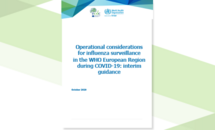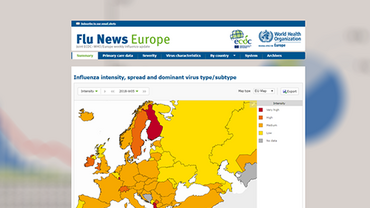Operational considerations for influenza surveillance in the WHO European Region during COVID-19: interim guidance
This document outlines operational considerations for how to support the continuity of national influenza surveillance systems and public health laboratories for the epidemiological and virological surveillance for influenza in the 2020–2021 season during the ongoing COVID-19 pandemic. In addition, it describes how these systems might be used to contribute to COVID-19 surveillance.
Executive Summary
Key messages
For sentinel primary care influenza surveillance:
- It is important to maintain existing influenza-like illness (ILI) and acute respiratory infection (ARI)case definitions, where possible.
- When the number of cases presenting to sentinel surveillance sites is low, all patients meeting the case definition for ILI or ARI should be sampled.
- Sampled patients meeting the ILI or ARI case definition should ideally be tested concurrently for influenza and SARS-CoV-2 viruses.
- Epidemiological data on ILI should continue to be collected.
- Perform subtyping/lineage determination for all influenza-positive specimens.
- Where sentinel primary care surveillance for influenza has been disrupted because of COVID-19 testing strategies, explore alternative approaches such as patient self-sampling and the utility of telephone consultation syndromic data.
For non-sentinel surveillance:
- Non-sentinel specimens from primary and secondary care should be prioritized for COVID-19 testing; in addition, influenza testing should be performed in parallel for people at risk of developing severe disease (the elderly and those with underlying diseases).
- A random sample of all patients in these settings could be considered for influenza testing, based on clinical judgement and the level of influenza circulation, including further genetic and/or antigenic characterisation and antiviral resistance testing at national influenza centres or reference laboratories.
For hospital influenza surveillance:
- Important to maintain existing SARI case definition, where possible
- Test and report all SARI cases for influenza and SARS-CoV-2 simultaneously, where possible when influenza is known to be circulating
Laboratory considerations:
- Sequence a representative subset of influenza and SARS-CoV-2 viruses (date, geographical region, age, severity).
- Share a representative subset of influenza-positive specimens with national influenza centres or reference laboratories.
- At least 10% of the influenza viruses, or all when low circulation observed, should be characterised genetically and/or antigenically.
- At least 10% of the influenza viruses, or all when low circulation observed, should be tested (phenotypically and/or genotypically) for antiviral resistance








